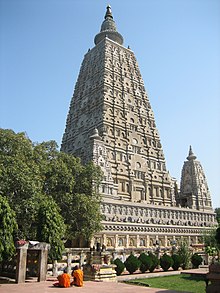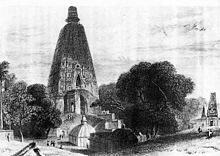Mahabodhi temple
The Mahabodhi Temple ( Sanskrit : maha = large, bodhi = awakening) is a Buddhist temple in Bodhgaya in the northeast Indian state of Bihar , which was originally built in the 2nd century. On the west side of the temple there is an offshoot of the poplar fig , under which Siddhartha Gautama , the historical Buddha , who, according to tradition , attained the awakening ( Bodhi ). In June 2002, the temple was added to the UNESCO World Heritage List.
Location and architecture
The Mahabodi Temple is a 55 m high brick building from the 1st to 3rd centuries AD. The outer facade comprises seven steps and is decorated with numerous statues of Buddha . The frieze that runs around the base of the temple on three sides shows 85 sandstone Buddhas from the Sunga period (1st century BC). Inside the temple there is a gilded statue of the meditating Buddha. On the north side of the temple extends the Jewel Path ( Chankramanar ), which consists of 19 stone lotus blossoms, which mark the path where, according to tradition, Buddha practiced walking meditation in the second week after his Bodhi experience. The Tempelhof houses numerous stupas .
On the west side of the large pyramid-shaped stupa is the holy Mahabodhi , a poplar fig ( ficus religiosa , also Bodhi tree ), which, according to tradition, is a descendant of the tree under which Siddhartha Gautama acquired Bodhi. Under the Bodhi tree, the diamond throne ( Vajrasana ), a platform made of red sandstone, marks the place where he sat down for meditation .
history
Around 250 BC The Buddhist ruler Ashoka visited Bodhgaya with the intention of creating a place of remembrance there. Ashoka had the Bodhi tree surrounded by a stone fence and marked the holy place with an edict column with an elephant capital. Both are not preserved.
In the Sunga period, an open pavilion with stone pillars was built around the Bodhi tree and the diamond throne was laid out. The Mahabodhi Temple was built during the Kushana period in the 2nd century. The older part of the temple is made of sandstone. In 625 the temple and the original Mahabodhi tree fell victim to destruction during a campaign by the Bengali king Shashanka. A little later, the younger part of the temple was rebuilt from coarse granite. The Mahabodhi tree, which was then newly planted and still exists today, is an offshoot of the Sri Mahabodhi in Anuradhapura ( Sri Lanka ), which in turn was established in the 3rd century BC. By Sangamitta, the daughter of King Ashoka, is a cutting of the original tree brought to Sri Lanka. Around the year 635, the Chinese monk Xuanzang visited the temple during his pilgrimage and left a description of the place in his travelogue.
After destruction, the temple had to be fundamentally restored or rebuilt several times. For centuries the temple in Bodhgaya was one of the great Buddhist pilgrimage destinations, which was visited by monks from all those countries in which Buddhism had spread. In the 12th and 13th centuries, restorations were carried out by the Burmese who also built the four small towers at the corners of the large stupa.
With the conquest of large parts of the Indian subcontinent by Muslim rulers (cf. Mughal Empire ) from the 12th century and the resurgence of Hinduism , the Mahabodhi temple finally fell into oblivion and partly fell into disrepair. It was not until the late 19th century that Buddhists, again from Burma, managed to agree with the British colonial rulers that the temple should be restored as a Buddhist sanctuary. The restoration work was finished in 1889.
Current status
After India's independence in 1949, a committee was set up by parliament, to which administration of the sanctuary was entrusted together with the government of Bihar. The temple administration committee, which consists of four Buddhists and four Hindus, first met in 1953. In 1973, a "Buddha Gaya Temple Advisory Board" was formed, which is composed of 21 members from different nations. Long-term efforts by Buddhist monks to transfer the chairmanship of the temple administration committee to a Buddhist initially failed because of the legal situation, since the temple administration law of 1949 provided that only one Hindu was allowed to preside over the committee. Since an amendment to the law in 2013, the head of the Gaya district can now chair the committee, even if he is not a Hindu.
The UNESCO took the Temple in June 2002 in the list of World Heritage in.
On July 7, 2013, strangers carried out a multiple bomb attack on the Mahabodhi temple complex, a Karmapa monastery school and other targets in Bodhgaya, which was little visited that day . Two monks were injured. In August 2013, the Indian Ministry of the Interior responded to a request by the government of Bihar to provide special units of the Indian Federal Police (CISF) to protect the UNESCO World Heritage Site. The Mahabodhi Temple is the only religious site in India that is protected by special units of the federal police. In November 2013, the Indian government agency "National Investigation Agency" announced that the Islamist terrorist group "Indian Mujahedeen" was responsible for the attack.
literature
- Alexander Cunningham: Mahâbodhi or the great Buddhist temple under the Bodhi tree at Buddha-Gaya . Varanasi: Indological Book House [approx. 1960].
- Alan Michael Trevithick: The revival of Buddhist pilgrimage at Bodh Gaya (1811-1949). Anagarika Dharmapala and the Mahabodhi Temple . Delhi: Motilal Banarsidass 2006.
- Tara N. Doyle: Liberate the Mahabodhi Temple! Socially Engaged Buddhism, Dalit-Style. In: Steven Heine, Charles Prebish (eds), Buddhism in the Modern World . Oxford University Press, 2003, ISBN 0-19-514698-0 , pp. 249-280.
- Kinnard, Jacob N. (1998). When Is The Buddha Not the Buddha? The Hindu / Buddhist Battle over Bodhgayā and Its Buddha Image , Journal of the American Academy of Religion 66 (4), 817-839
- Knopf, Rainer (2000). Bodh-Gaya: An International Center for Buddhism in a Non-Buddhist Environment , International Asia Forum 31 (3-4), 289-314
Web links
- Entry on the UNESCO World Heritage Center website ( English and French ).
- indiamonuments.org: Photographs from Bodh Gaya
- Mahabodhi Temple , history and further links (English)
Individual evidence
- ^ Amendment allows non-Hindu to head Bodh Gaya temple committee , The Hindu, August 1, 2013
- ^ Bomb attack in Tempel , in: Süddeutsche Zeitung, July 8, 2013, No. 155, p. 6
- ↑ Manan Kumar: Finally, Mahabodhi temple gets CISF cover , in: dnaindia.com, August 1, 2013 , accessed January 6, 2014
- ↑ Deeptiman Tiwari: Ranchi document helps NIA crack Bodh Gaya blast case , in: Times of India, November 6, 2013 , accessed on January 6, 2014
Coordinates: 24 ° 41 ′ 45.6 ″ N , 84 ° 59 ′ 29 ″ E




